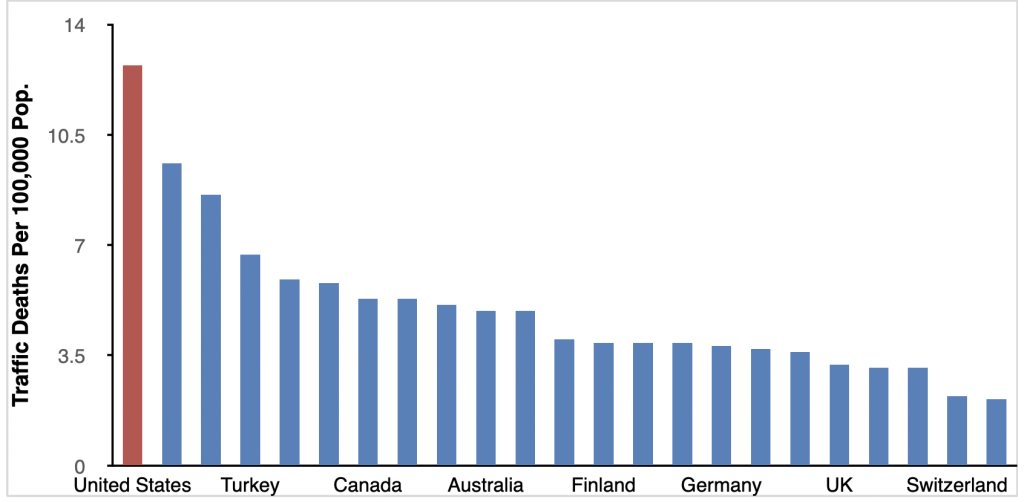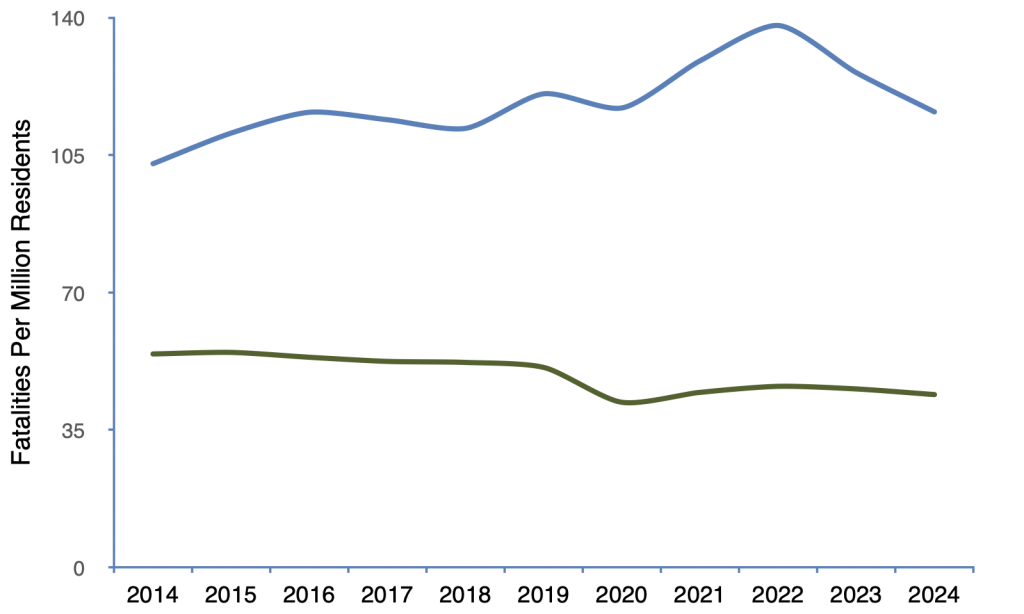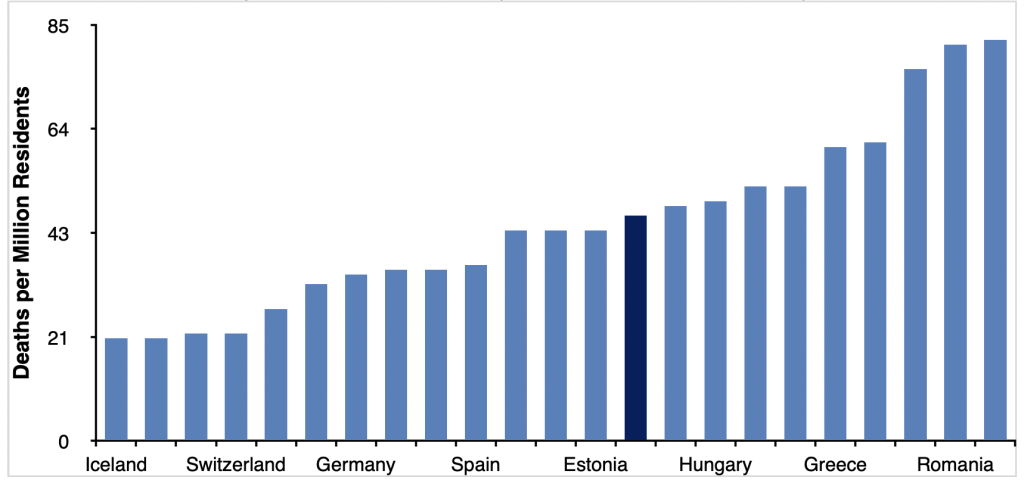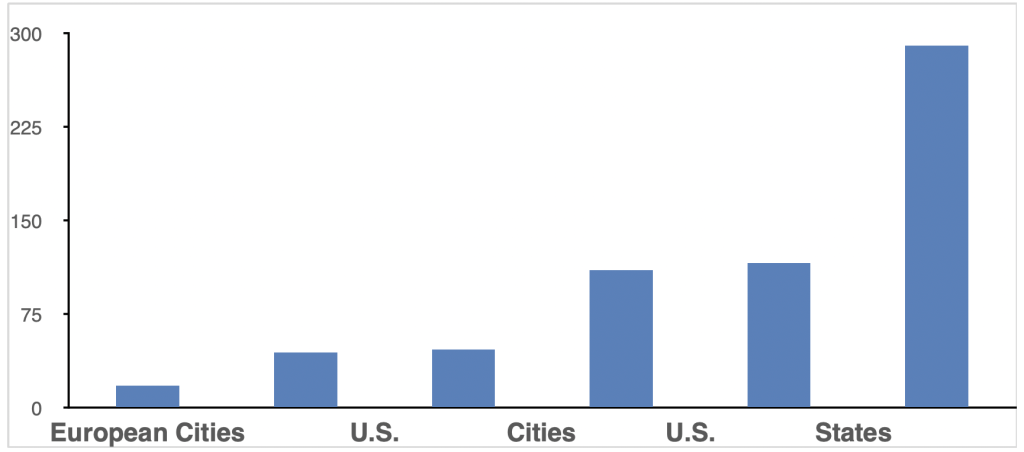The U.S. has much higher traffic fatality rates than peer countries due to automobile dependency and sprawl. Better planning can reduce these human sacrifices.

Ancient Canaanites were known for human sacrifices to their god Baal. The Greek historian Diodorus Siculus describes hundreds of children being sacrificed one year in Carthage:
“They selected two hundred of the noblest children and sacrificed them publicly; and others who were under suspicion sacrificed themselves voluntarily, in a number not less than three hundred. There was in their city a bronze image of Cronus, extending its hands, palms up and sloping toward the ground, so that each of the children when placed thereupon rolled down and fell into a sort of gaping pit filled with fire.”
North Americans have a modern version of this gruesome image. The U.S. has a much higher traffic fatality rate than peer countries largely due to automobile dependency and sprawl which force residents to drive more annual miles at higher speed than they would otherwise choose, resulting in tens of thousands of annual gruesome but preventable traffic deaths and disabilities.
Last year the U.S. had 116 traffic deaths per million residents, comparted with 44 deaths per million residents in Europe. (Note that sources vary in how they measure traffic deaths. For this analysis I used the lower-bound estimate of 39,345 deaths reported by the National Highway Traffic Safety Administration, which only considers traffic deaths within 30 days of a crash that occurs on public roads, rather than the 44,680 traffic deaths reported by the National Safety Council which also includes deaths in parking lots and driveways that occur within a year of a collision. Measured this way, in 2024 the U.S. had 134 traffic deaths per million residents.)
Traffic Death Rates by Country (WHO 2023)

This reflects long-term trends. During the last decade traffic death rates increased in the U.S. while they declined in Europe, as illustrated below.
US Versus European Traffic Fatality Trends (IIHS 2024; European Commission 2023)

The figure below compares traffic fatality rates by U.S. states. Despite similar vehicle and road design standards, the highest ranking states have about five times the death rate as the the lowest-ranking states.
Traffic Fatality Rates by U.S. States (IIHS 2024)

U.S. traffic death rates are much higher than in Europe.
Traffic Fatality Rates by European Countries (European Commission 2023)

To make these easier to compare I present U.S. and European crash ranges as line graphs using the same scale. This shows that the most dangerous countries in Europe have traffic fatality rates comparable to the lowest death rates among U.S. states (about 50 to 80 fatalities per million residents).
US Versus European Traffic Death Rates (IIHS 2024; European Commission 2023)

There are similar ranges within countries. In both the U.S. and Europe residents of compact, multimodal communities (that is, transit-oriented developments and 15-minute neighborhoods) have about a fifth of the traffic death rates as in automobile-dependent, sprawled areas. The following graph compares crash fatality rate estimates. Sprawled areas have an order of magnitude higher traffic fatality rates than in compact, multimodal communities.
Traffic Fatality Rates Compared

Several factors help explain these large disparities in fatality rates.
- Europeans drive fewer annual miles than in the U.S. which reduces their risk exposure.
- The European Union requires all cities to implement Sustainable Urban Mobility Plans (SUMPs) that support multimodal planning and transportation demand management.
- The European Union vehicle safety standards protect pedestrians as well as occupants.
- European vehicles are smaller which reduces total risks.
- European countries appear to be more committed to traffic safety programs, such as Vision Zero, which integrate safety into all transportation policies and planning decisions. The EU’s Sustainable and Smart Mobility Strategy includes policies that prioritize lower urban speed limits, pedestrian zones, physical separation between bicycle and car traffic, plus data-based traffic enforcement and education to affect behavior.
I am writing this column during a family holiday in The Netherlands, so I’ll use it as an example. That country has 35 traffic deaths per million residents, less than a third of the U.S., and Amsterdam had only about 20 deaths per million residents, much lower than U.S. cities. Dutch traffic actually seems dangerous because the huge number of bicyclists who almost never wear helmets and often flaunt traffic rules — carrying passengers, riding on sidewalks and inebriated, for example — but it is actually much safer due to low automobile use and traffic speeds. Most European neighborhoods and some older North American neighborhoods (those that developed before 1950, or built recently with New Urbanist principles) have low traffic risk.
These cities are not just safer and healthier, they are also more affordable and livable. Although European cities have relatively high housing costs, as in North America, this is more than offset by lower transportation costs. Low- and moderate-income European households typically spend less than 10 percent of their incomes on transportation, about half of their peers in the U.S.
What can North American planners do to reduce excessive traffic deaths and injuries? My report, A New Traffic Safety Paradigm, summarizes research on ways to increase traffic safety. North American transportation agencies currently apply various older strategies, which should not be ignored, but to achieve additional crash reductions they need new strategies, such as those listed in the following table. The older strategies are targeted programs applied after most major transportation and land use planning decisions are made. New strategies include structural reforms involving more multimodal transportation planning, more compact development, transportation demand management incentives and parking policy reforms. This recognizes that all types of planning decisions affect transportation safety, and that many policies can increase safety in addition to other economic, social and environmental benefits.
Old and New Paradigm Traffic Safety Strategies
Old |
New |
|
|
The new paradigm expands traffic safety strategies to include structural reforms that increase transport system diversity and efficiency. They tend to provide many economic, social and environmental benefits in addition to safety.
What do you think? Are North Americans ready to reduce current human sacrifices to automobile dependency and sprawl?

Rethinking Redlining
For decades we have blamed 100-year-old maps for the patterns of spatial racial inequity that persist in American cities today. An esteemed researcher says: we’ve got it all wrong.

Planetizen Federal Action Tracker
A weekly monitor of how Trump’s orders and actions are impacting planners and planning in America.

California High-Speed Rail's Plan to Right Itself
The railroad's new CEO thinks he can get the project back on track. The stars will need to align this summer.

‘Displaced By Design:’ Report Spotlights Gentrification in Black Neighborhoods
A new report finds that roughly 15 percent of U.S. neighborhoods have been impacted by housing cost increases and displacement.

Nevada and Utah Groups Oppose Public Land Sell-Off Plan
A set of last-minute amendments to the budget reconciliation bill open up over half a million acres of federally managed land to sales.

More Than a Park: A Safe Haven for Generations in LA’s Chinatown
Alpine Recreation Center serves as a vital cultural and community hub in Los Angeles' Chinatown, offering a safe, welcoming space for generations of Chinese American residents to gather, connect, and thrive amidst rapid urban change.
Urban Design for Planners 1: Software Tools
This six-course series explores essential urban design concepts using open source software and equips planners with the tools they need to participate fully in the urban design process.
Planning for Universal Design
Learn the tools for implementing Universal Design in planning regulations.
City of Clovis
City of Moorpark
City of Camden Redevelopment Agency
City of Astoria
Transportation Research & Education Center (TREC) at Portland State University
Regional Transportation Commission of Southern Nevada
Toledo-Lucas County Plan Commissions



























